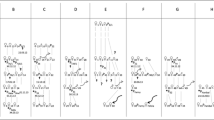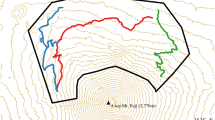Abstract
Using focal animal samples, the social organization of sifakas was studied in two forests for 2500 hr spread over 18 months. Data were also obtained on the size and composition of groups at two other sites. The size and adult sex ratio of groups varied widely within populations, although population-wide sex ratios approached unity. During the brief annual mating season, some males mated with females belonging to other groups. The response of both male and female group members to the approach of a nongroup male appeared to depend on his identity. It is argued that while group size may be constrained by the availability of resources, group composition reflects the effects of small-sample demographic variations rather than the outcome of reproductive competition among or between males and females. Spatial boundaries of groups do not coincide with social or reproductive boundaries even within a single breeding season; further study is needed of the processes whereby relationships are established and maintained between individuals from different groups.
Similar content being viewed by others
References
Altmann, S. A., and Altmann, J. (1970).Baboon Ecology, University of Chicago Press, Chicago.
Berenstein, L., and Wade, T. D. (1983). Intrasexual selection and male mating strategies in baboons and macaques.Int. J. Primatol. 4: 201–235.
Boelkins, R. C., and Wilson, A. P. (1972). Intergroup social dynamics of the Cayo Santiago rhesus (Macaca mulatto) with special reference to changes in group membership by males.Primates 13: 125–140.
Boggess, J. (1979). Troop male membership changes and infant killing in langurs.Folia primatol. 32: 65–107.
Boggess, J. (1980). Intermale relations and troop male membership changes in langurs (Presbytis entellus) in Nepal.Int. J. Primatol. 1: 233–274.
Cheney, D. L. (1981). Inter-group encounters among free-ranging vervet monkeys.Folia primatol. 35: 124–146.
Cheney, D. L., and Seyfarth, R. M. (1977). Behaviour of adult and immature male baboons during inter-group encounters.Nature (Lond.) 269: 404–406.
Cheney, D. L., and Seyfarth, R. M. (1982). Recognition of individuals within and between groups of free-ranging vervet monkeys.Am. Zool. 22: 519–529.
Cheney, D. L., and Seyfarth, R. M. (1983). Nonrandom dispersal in free-ranging vervet monkeys: Social and genetic consequences.Am. Nat. 122: 392–412.
Chepko-Sade, D., and Sade, D. S. (1979). Patterns of group splitting within matrilineal kinship groups. A study of social group structure inMacaca mulatto. Behav. Ecol. Sociobiol. 5: 67–86.
Clark, A. B. (1978). Sex ratio and local resource competition in a prosimian primate.Science 201: 163–165.
Crook, J. H., Ellis, J. E., and Goss-Custard, J. D. (1976). Mammalian social systems: Structure and function.Anim. Behav. 24: 261–274.
DeVore, I. (ed.) (1965).Primate Behavior: Field Studies of Monkeys and Apes, Holt, Rinehart and Winston, New York.
Drickamer, L. C. (1975). Patterns of space utilization and group interactions among free-ranging Macaca mulatto.Primates 16: 23–33.
Drickamer, L. C., and Vessey, S. H. (1973). Group-changing in free-ranging rhesus monkeys.Primates 14: 359–368.
Greenwood, P. J. (1980). Mating systems, philopatry, and dispersal in birds and mammals.Anim. Behav. 30: 1140–1160.
Hamilton, W. J., Buskirk, R. E., and Buskirk, W. H. (1975). Chacma baboon tactics during inter-troop encounters.J. Mammal. 56: 857–870.
Harrington, J. E. (1977). Discrimination between males and females by scent inLemur fulvus.Anim. Behav. 25: 147–151.
Hausfater, G. (1972). Intergroup behavior of free-ranging rhesus monkeys (Macaca mulatto).Folia primatol. 18: 78–107.
Hausfater, G. (1975). Dominance and reproduction in baboons (Papio cynocephalus): A quantitative analysis.Contrib. Primatol. 7, Karger, Basel.
Henzi, S. P., and Lucas, J. W. (1980). Observations on the inter-troop mavements of adult vervet monkeys (Cercopithecus aethiops).Folia primatol. 33: 220–235.
Hinde, R. A. (1976). Interactions, relationships and social structure.Man 11: 1–17.
Jolly, A. (1966).Lemur Behavior, University of Chicago Press, Chicago.
Jolly, A. (1972). Troop continuity and troop spacing inPropithecus verreauxi andLemur catta at Berenty (Madagascar).Folia primatol. 17: 335–362.
Jolly, A. (1984). The puzzle of female feeding priority. In Small, M. (ed.),Female Primates: Studies by Women Primatologists, Alan R. Liss, New York.
Jolly, A., Gustafson, H., Oliver, W. L. R., and O’Connor, S. M. (1982).Propithecus verreauxi population and ranging at Berenty, Madagascar, 1975 and 1980.Folia primatol. 39: 124–144.
Jones, K. C. (1983). Inter-troop transfer ofLemur catta males at Berenty, Madagascar.Folia primatol. 50: 145–160.
Kawanaka, K. (1973). Intertroop relations among Japanese monkeys.Primates 14: 113–159.
Kleiman, D. G. (1977). Monogamy in mammals.Q. Rev. Biol. 52: 39–69.
Lindburg, D. G. (1969). Rhesus monkeys: Mating season mobility of adult males.Science 166: 1176–1178.
Meikle, D. B., and Vessey, S. H. (1981). Nepotism among rhesus monkey brothers.Nature (Lond.) 194: 160–161.
Packer, C. (1979). Intertroop transfer and inbreeding avoidance inPapio anubis.Anim. Behav. 27: 1–36.
Packer, C., and Pusey, A. E. (1979). Female aggression and male membership in troops of Japanese macaques and olive baboons.Folia primatol. 31: 212–218.
Pearl, M. C. (1982).Net works of Social Relations Among Himalayan Rhesus Monkeys (Macaca mulatta), Ph.D. thesis, Yale University, New Haven, Conn.
Petter, J. -J. (1962). Recherches sur l’écologie et l’éthologie des Lémuriens malgaches.Mem. Mus. Natl. Hist. Nat. Paris Sér. A 27: 1–146.
Pusey, A. E. (1980). Inbreeding avoidance in chimpanzees.Anim. Behav. 28: 543–552.
Richard, A. F. (1974). Patterns of mating inPropithecus verreauxi. In Martin, R. D., Doyle, G., and Walker, A. C. (eds.),Prosimian Biology, Duckworth, London, pp. 49–74.
Richard, A. F. (1976). Preliminary observations on a birth in the wild and maternal behavior inPropithecus verreauxi.Primates 17: 357–366.
Richard, A. F. (1978).Behavioral Variation: Case Study of a Malagasy Lemur, Bucknell University Press, Lewisburg, Pa.
Richard, A. F., and Heimbuch, R. (1975). Social structure and patterns of dispersion inPropithecus verreauxi. In Tattersall, I., and Sussman, R. W. (eds.),Lemur Biology, Plenum, New York, pp. 313–333.
Sade, D. S. (1967). Determinants of dominance in a group of free-ranging rhesus monkeys. In Altmann, S. A. (ed.),Social Communication Among Primates, University of Chicago Press, Chicago, pp. 99–122.
Sade, D. S. (1972). Longitudinal study of social behavior of rhesus monkeys. In Tuttle, R. H. (ed.),The Functional and Evolutionary Biology of Primates, Aldine Atherton, Chicago, pp. 378–398.
Schilling, A. (1979). Olfactory communication in prosimians. In Doyle, G. A., and Martin, R. D. (eds.),The Study of Prosimian Behavior, Duckworth, London, pp. 461–542.
Smuts, B. (1982).Special Relationships Between Adult Male and Female Olive Baboons (Papio anubis), Ph.D. thesis, Stanford University, Stanford, Calif.
Stacey, P. B. (1982). Female promiscuity and male reproductive success in social birds and mammals.Am. Nat. 120: 51–64.
Struhsaker, T. T. (1975).The Red Colobus Monkey, University of Chicago Press, Chicago.
Strum, S. C. (1982). Agonistic dominance in male baboons: an alternative view.Int. J. Primatol. 3: 175–202.
Takahata, Y. (1982). Social relations between adult males and females of Japanese monkeys in the Arashiyama E. Troop.Primates 23: 1–23.
Trivers, R. L. (1972). Parental investment and sexual selection. In Campbell, B. (ed.),Sexual Selection and the Descent of Man, Aldine, Chicago., pp. 136–179.
Waser, P. M. (1975). Experimental playbacks show vocal mediation of intergroup avoidance in a forest monkey.Nature (London) 255: 56–58.
Waser, P. M. (1976).Cercocebus albigena: site attachment, avoidance, and intergroup spacing.Am. Nat. 110: 911–935.
Wheatley, B. P. (1982). Adult male replacement inMacaca fascicularis of East Kalimantan, Indonesia.Int. J. Primatol. 3: 203–219.
Wrangham, R. W. (1980). An ecological model of female-bonded primate groups.Behaviour 75: 262–300.
Author information
Authors and Affiliations
Rights and permissions
About this article
Cite this article
Richard, A.F. Social boundaries in a Malagasy Prosimian, the Sifaka (Propithecus verreauxi). Int J Primatol 6, 553–568 (1985). https://doi.org/10.1007/BF02692288
Received:
Revised:
Issue Date:
DOI: https://doi.org/10.1007/BF02692288




